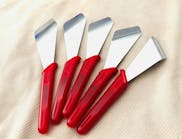Major key catalogs contain more than 6,000 different key-blank varieties. During the early 20th century, locksmiths had to learn the differences between key blanks used by Welch, Barrows, Sager, Clinton, Reading and dozens more. Somewhere in the distant past, most of these companies disappeared along with the necessity for locksmiths to keep a sizeable inventory of obsolete blanks. Two keyways, KW1 and SC1, emerged as the popular blanks for residential hardware. Imported lock manufacturers followed along by offering either KW1 or SC1 keyways so their products could be keyed by using existing hardware.
One positive reason for using a KW1 or an SC1 keyway is that the main part of the keyway is vertical. Every depth of cut is supported by the vertical key-blade section. Some depths of cut on rounded key-blank shapes, such as Y1, might not be supported fully by the key blade, which then might deter smooth operation.
Vertical keyways also allow simplified insertion and vertical movement of lock picks. Either by design or by chance, the result of using vertical keyways is that the security of standard pin-and-driver residential locks on the market today is less than ever before. Corrugated keyways, such as Eagle, Barrows and Lockwood, have disappeared along with the security benefits of their protective rounded-blade shapes.
Lishi recently introduced individual lock picks for SC1, KW1, AM3 and BE2 keyways that take advantage of the vertical keyways. As a side note, Lishi wording apparently is used by more than one company. This article will refer to the Lishi style of lock picks and not to any specific manufacturer. (We used a KW5 Lishi pick for picking standard Kwikset pin tumbler locks in this article.) Consult your locksmith distributor for more information.
Normal lock picking while using rakes and tension wrenches isn’t a perfect art form. Skilled locksmiths might have increased lock-picking success through knowledge and experience, but it’s impossible to know exactly how long it will take before the lock plug finally rotates. One comparison might be with raking leaves: Moving one leaf in a pile while others are undisturbed is just a matter of luck. And running a rake pick across a row of tumblers has a similar effect.
Lishi has moved lock picking to a new level, at least for locks that contain vertical keyways. Each Lishi pick contains a plate that has markings showing the exact spacing and cut-depth heights used by a specific lock.
Lishi picks use positional lock picking. Instead of randomly raking across a row of tumblers, a Lishi pick contains one lifting probe. The probe can be set at a specific space marking, which allows each tumbler to be moved individually into the open shearline position.
Compared with using normal lock picks and tension wrenches, Lishi picks require only a small amount of training. A fold-out lever provides rotating tension, and only a small amount of tension is required.
Variables, such as pin lengths and plug-hole diameters, typically prevent successfully picking tumblers in a uniform order from first to last. Such isn’t the case with a Lishi pick. First, you insert the pick into the lock with a small amount of rotation tension. The Lishi picking routine then consists of placing the probe either at the first or last tumbler in line — depth markings are shown on the Lishi pick. Start with the deepest depth and move the probe towards shallower depths. Two things will occur: The probe either will indicate a slight stoppage as the tumbler is aligned at the shearline, or the probe can be moved through all depths without stopping.
If no probe stoppage is indicated, then move to the next tumbler in line and repeat the same procedure. Various lengths of tumblers and tumbler-hole offset imperfections can cause variations in the picking order. This is the strength of the Lishi system. Locksmiths can move precisely from one space to the next. As one tumbler is raised to the shearline, other tumblers then will be put under tension for picking.
A secondary feature of Lishi tools is in decoding a cylinder. The plug is turned, the probe can be set at each space and the probe can be used to determine individual depths.
It took me no more than a minute to pick a KW1 lock cylinder on several Kwikset and Master Lock cylinders in my collection with the Lishi pick regardless of the key combination. People can say that a KW1 is a simple lock to pick with a rake and tension wrench. This might be true, but a Lishi pick is difficult to beat when you know exactly how long it will take and can watch the picking probe as it moves through the picking action.
One drawback is that KW5 Lishi picks won’t fit into any Kwikset SmartKey cylinder in my collection. It appears that SmartKey cylinders use a slightly narrower keyway. KW5 Lishi tools are narrow enough to fit into standard KW1 keyways but are too wide to fit into SmartKey keyways. As a result, no tests could be performed to determine whether SmartKey cylinders at least could be decoded with a Lishi pick.






